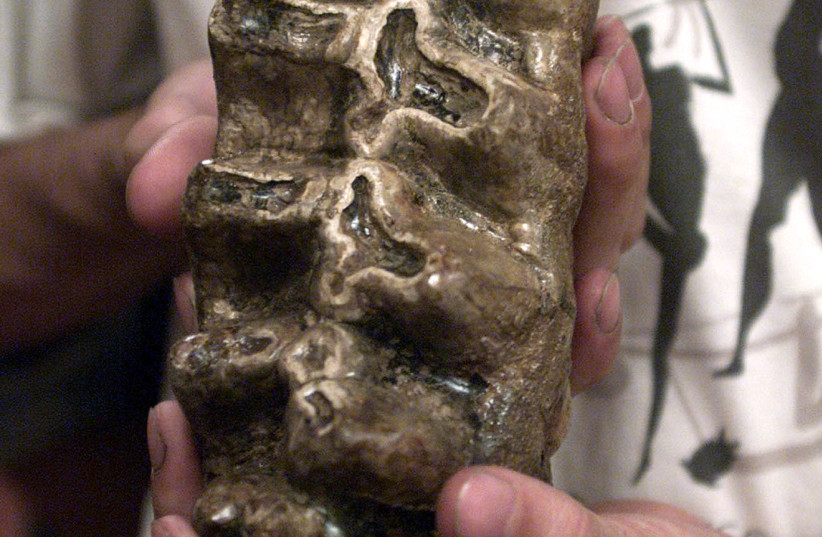Our contributions are an informal communication and represent our own best judgment. These comments do not bind or obligate FDA.
The US Food and Drug Administration and Ohio State Innovation Foundation report a patent 17-786,129 pending to Gennova Biopharmaceuticals. The authors report no other conflict of interest in this work.
2. David CV, Craft N. Cutaneous and mucocutaneous leishmaniasis. Dermatol Ther. 2009;22(6):491. doi:10.1111/j.1529-8019.2009.01272.x
3. Reithinger R, Dujardin JC, Louzir H, Pirmez C, Alexander B, Brooker S. Cutaneous leishmaniasis. Lancet Infect Dis. 2007;7(9):581–596. doi:10.1016/S1473-3099(07)70209-8
4. Burza S, Croft SL, Boelaert M. Leishmaniasis. Lancet. 2018;392(10151):951–970. doi:10.1016/S0140-6736(18)31204-2
5. Alcantara LM, Ferreira TCS, Gadelha FR, Miguel DC. Challenges in drug discovery targeting TriTryp diseases with an emphasis on leishmaniasis. Int J Parasitol Drugs Drug Resist. 2018;8(3):430–439. doi:10.1016/j.ijpddr.2018.09.006
6. Tiuman TS, Santos AO, Ueda-Nakamura T, Filho BP, Nakamura CV. Recent advances in leishmaniasis treatment. Int J Infect Dis. 2011;15(8):e525–32. doi:10.1016/j.ijid.2011.03.021
7. McGwire BS, Satoskar AR. Leishmaniasis: clinical syndromes and treatment. QJM. 2014;107(1):7–14. doi:10.1093/qjmed/hct116
8. Varma N, Naseem S. Hematologic changes in visceral leishmaniasis/kala azar. Indian J Hematol Blood Transfus. 2010;26(3):78. doi:10.1007/s12288-010-0027-1
9. Zijlstra EE. The immunology of post-kala-azar dermal leishmaniasis (PKDL). Parasit Vectors. 2016;9:464. doi:10.1186/s13071-016-1721-0
10. Lypaczewski P, Matlashewski G. Leishmania donovani hybridisation and introgression in nature: a comparative genomic investigation. Lancet Microbe. 2021;2(6):e250–e258. doi:10.1016/S2666-5247(21)00028-8
11. Adaui V, Lye LF, Akopyants NS, et al. Association of the endobiont double-stranded RNA virus LRV1 with treatment failure for human leishmaniasis caused by leishmania braziliensis in Peru and Bolivia. J Infect Dis. 2016;213(1):112–121. doi:10.1093/infdis/jiv354
12. Kuhlmann FM, Robinson JI, Bluemling GR, Ronet C, Fasel N, Beverley SM. Antiviral screening identifies adenosine analogs targeting the endogenous dsRNA Leishmania RNA virus 1 (LRV1) pathogenicity factor. Proc Natl Acad Sci U S A. 2017;114(5):E811–E819. doi:10.1073/pnas.1619114114
13. Hartley MA, Ronet C, Zangger H, Beverley SM, Fasel N. Leishmania RNA virus: when the host pays the toll. Front Cell Infect Microbiol. 2012;2:99. doi:10.3389/fcimb.2012.00099
14. Uliana SRB, Trinconi CT, Coelho AC. Chemotherapy of leishmaniasis: present challenges. Parasitology. 2018;145(4):464–480. doi:10.1017/S0031182016002523
15. Moore EM, Lockwood DN. Treatment of visceral leishmaniasis. J Glob Infect Dis. 2010;2(2):151–158. doi:10.4103/0974-777X.62883
16. Ponte-Sucre A, Gamarro F, Dujardin JC, et al. Drug resistance and treatment failure in leishmaniasis: a 21st century challenge. PLoS Negl Trop Dis. 2017;11(12):e0006052. doi:10.1371/journal.pntd.0006052
17. Madusanka RK, Silva H, Karunaweera ND. Treatment of cutaneous leishmaniasis and insights into species-specific responses: a narrative review. Infect Dis Ther. 2022;11(2):695–711. doi:10.1007/s40121-022-00602-2
18. Alrajhi AA, Ibrahim EA, De Vol EB, Khairat M, Faris RM, Maguire JH. Fluconazole for the treatment of cutaneous leishmaniasis caused by Leishmania major. N Engl J Med. 2002;346(12):891–895. doi:10.1056/NEJMoa011882
19. Galvao EL, Rabello A, Cota GF. Efficacy of azole therapy for tegumentary leishmaniasis: a systematic review and meta-analysis. PLoS One. 2017;12(10):e0186117. doi:10.1371/journal.pone.0186117
20. Saenz RE, Paz H, Berman JD. Efficacy of ketoconazole against Leishmania braziliensis panamensis cutaneous leishmaniasis. Am J Med. 1990;89(2):147–155. doi:10.1016/0002-9343(90)90292-l
21. Ballou WR, McClain JB, Gordon DM, et al. Safety and efficacy of high-dose sodium stibogluconate therapy of American cutaneous leishmaniasis. Lancet. 1987;2(8549):13–16. doi:10.1016/s0140-6736(87)93053-4
22. Sundar S, Chakravarty J. Liposomal amphotericin B and leishmaniasis: dose and response. J Glob Infect Dis. 2010;2(2):159–166. doi:10.4103/0974-777X.62886
23. Gadelha EPN, Ramasawmy R, da Costa Oliveira B, et al. An open label randomized clinical trial comparing the safety and effectiveness of one, two or three weekly pentamidine isethionate doses (seven milligrams per kilogram) in the treatment of cutaneous leishmaniasis in the Amazon Region. PLoS Negl Trop Dis. 2018;12(10):e0006850. doi:10.1371/journal.pntd.0006850
24. Krause G, Kroeger A. Topical treatment of American cutaneous leishmaniasis with paramomycin and methylbenzethonium chloride: a clinical study under field conditions in Ecuador. Trans R Soc Trop Med Hyg. 1994;88(1):92–94. doi:10.1016/0035-9203(94)90517-7
25. Soto J, Grogl M, Berman J, Olliaro P. Limited efficacy of injectable aminosidine as single-agent therapy for Colombian cutaneous leishmaniasis. Trans R Soc Trop Med Hyg. 1994;88(6):695–698. doi:10.1016/0035-9203(94)90235-6
26. Zerpa O, Ulrich M, Blanco B, et al. Diffuse cutaneous leishmaniasis responds to miltefosine but then relapses. Br J Dermatol. 2007;156(6):1328–1335. doi:10.1111/j.1365-2133.2007.07872.x
27. Wolf Nassif P, De Mello TF, Navasconi TR, et al. Safety and efficacy of current alternatives in the topical treatment of cutaneous leishmaniasis: a systematic review. Parasitology. 2017;144(8):995–1004. doi:10.1017/S0031182017000385
28. Khamesipour A. Therapeutic vaccines for leishmaniasis. Expert Opin Biol Ther. 2014;14(11):1641–1649. doi:10.1517/14712598.2014.945415
29. Husein-ElAhmed H, Gieler U, Steinhoff M. Evidence supporting the enhanced efficacy of pentavalent antimonials with adjuvant therapy for cutaneous leishmaniasis: a systematic review and meta-analysis. J Eur Acad Dermatol Venereol. 2020;34(10):2216–2228. doi:10.1111/jdv.16333
30. Berbert TRN, de Mello TFP, Wolf Nassif P, et al. Pentavalent antimonials combined with other therapeutic alternatives for the treatment of cutaneous and mucocutaneous leishmaniasis: a systematic review. Dermatol Res Pract. 2018;2018:1–21. doi:10.1155/2018/9014726
31. Garza-Tovar TF, Sacriste-Hernandez MI, Juarez-Duran ER, Arenas R. An overview of the treatment of cutaneous leishmaniasis. Fac Rev. 2020;9:28. doi:10.12703/r/9-28
32. Velasco-Castrejon O, Walton BC, Rivas-Sanchez B, et al. Treatment of cutaneous leishmaniasis with localized current field (radio frequency) in Tabasco, Mexico. Am J Trop Med Hyg. 1997;57(3):309–312. doi:10.4269/ajtmh.1997.57.309
33. Aronson NE, Wortmann GW, Byrne WR, et al. A randomized controlled trial of local heat therapy versus intravenous sodium stibogluconate for the treatment of cutaneous Leishmania major infection. PLoS Negl Trop Dis. 2010;4(3):e628. doi:10.1371/journal.pntd.0000628
34. Volpedo G, Huston RH, Holcomb EA, et al. From infection to vaccination: reviewing the global burden, history of vaccine development, and recurring challenges in global leishmaniasis protection. Expert Rev Vaccines. 2021;20(11):1431. doi:10.1080/14760584.2021.1969231
35. Panagiotopoulos A, Stavropoulos PG, Hasapi V, Papakonstantinou AM, Petridis A, Katsambas A. Treatment of cutaneous leishmaniasis with cryosurgery. Int J Dermatol. 2005;44(9):749–752. doi:10.1111/j.1365-4632.2005.02628.x
36. Al-Qubati Y, Janniger EJ, Schwartz RA. Cutaneous leishmaniasis: cryosurgery using carbon dioxide slush in a resource-poor country. Int J Dermatol. 2012;51(10):1217–1220. doi:10.1111/j.1365-4632.2011.04958.x
37. Lopez-Carvajal L, Cardona-Arias JA, Zapata-Cardona MI, Sanchez-Giraldo V, Velez ID. Efficacy of cryotherapy for the treatment of cutaneous leishmaniasis: meta-analyses of clinical trials. BMC Infect Dis. 2016;16:360. doi:10.1186/s12879-016-1663-3
38. Aronson N, Herwaldt BL, Libman M, et al. Diagnosis and treatment of leishmaniasis: clinical practice guidelines by the infectious diseases society of America (IDSA) and the American society of tropical medicine and hygiene (ASTMH). Clin Infect Dis. 2016;63(12):1539. doi:10.1093/cid/ciw742
39. Pinheiro AC, de Souza MVN. Current leishmaniasis drug discovery. RSC Med Chem. 2022;13(9):1029. doi:10.1039/d1md00362c
40. Thompson AM, O’Connor PD, Marshall AJ, et al. 7-substituted 2-Nitro-5,6-dihydroimidazo 2,1-b 1,3 oxazines: novel antitubercular agents lead to a new preclinical candidate for visceral leishmaniasis. J Med Chem. 2017;60(10):4212. doi:10.1021/acs.jmedchem.7b00034
41. Van den Kerkhof M, Leprohon P, Mabille D, et al. Identification of resistance determinants for a promising antileishmanial oxaborole series. Microorganisms. 2021;9(7):1408. doi:10.3390/microorganisms9071408
42. Machado-Pinto J, Pinto J, da Costa CA, et al. Immunochemotherapy for cutaneous leishmaniasis: a controlled trial using killed Leishmania (Leishmania) amazonensis vaccine plus antimonial. Int J Dermatol. 2002;41(2):73–78. doi:10.1046/j.1365-4362.2002.01336.x
43. Mayrink W, Botelho AC, Magalhaes PA, et al. Immunotherapy, immunochemotherapy and chemotherapy for American cutaneous leishmaniasis treatment. Rev Soc Bras Med Trop. 2006;39(1):14–21. doi:10.1590/s0037-86822006000100003
44. Convit J, Ulrich M, Zerpa O, et al. Immunotherapy of American cutaneous leishmaniasis in Venezuela during the period 1990–99. Trans R Soc Trop Med Hyg. 2003;97(4):469–472. doi:10.1016/s0035-9203(03)90093-9
45. Datta A, Podder I, Das A, Sil A, Das NK. Therapeutic modalities in post kala-azar dermal leishmaniasis: a systematic review of the effectiveness and safety of the treatment options. Indian J Dermatol. 2021;66(1):34–43. doi:10.4103/ijd.IJD_264_20
46. Taslimi Y, Zahedifard F, Rafati S. Leishmaniasis and various immunotherapeutic approaches. Parasitology. 2018;145(4):497–507. doi:10.1017/S003118201600216X
47. Moafi M, Rezvan H, Sherkat R, Taleban R. Leishmania vaccines entered in clinical trials: a review of literature. Int J Prev Med. 2019;10:95. doi:10.4103/ijpvm.IJPVM_116_18
48. Shaddel M, Sharifi I, Karvar M, Keyhani A, Baziar Z. Cryotherapy of cutaneous leishmaniasis caused by Leishmania major in BALB/c mice: a comparative experimental study. J Vector Borne Dis. 2018;55(1):42–46. doi:10.4103/0972-9062.234625
49. Gedda MR, Singh B, Kumar D, et al. Post kala-azar dermal leishmaniasis: a threat to elimination program. PLoS Negl Trop Dis. 2020;14(7):e0008221. doi:10.1371/journal.pntd.0008221
50. Mansueto P, Seidita A, Vitale G, Cascio A. Transfusion transmitted leishmaniasis. What to do with blood donors from endemic areas? Travel Med Infect Dis. 2014;12(6 Pt A):617–627. doi:10.1016/j.tmaid.2014.10.011
51. Mirzabeigi M, Farooq U, Baraniak S, Dowdy L, Ciancio G, Vincek V. Reactivation of dormant cutaneous Leishmania infection in a kidney transplant patient. J Cutan Pathol. 2006;33(10):701–704. doi:10.1111/j.1600-0560.2006.00532.x
52. Antinori S, Cascio A, Parravicini C, Bianchi R, Corbellino M. Leishmaniasis among organ transplant recipients. Lancet Infect Dis. 2008;8(3):191–199. doi:10.1016/S1473-3099(08)70043-4
53. Peris MP, Esteban-Gil A, Ares-Gómez S, Morales M, Castillo JA, Moreno B. Characterization of lesions in the temporal muscle and the male reproductive system (epididymis and testicle) of dogs experimentally infected with Leishmania infantum with different clinical stages. Vet Parasitol. 2022;305. doi:10.1016/j.vetpar.2022.109700
54. Boechat VC, Pereira SA, Júnior AAVM, et al. Frequency, active infection and load of Leishmania infantum and associated histological alterations in the genital tract of male and female dogs. PLoS One. 2020;15(9):e0238188. doi:10.1371/journal.pone.0238188
55. Boechat VC, Mendes Junior AAV, Madeira M, et al. Occurrence of Leishmania infantum and associated histological alterations in the genital tract and mammary glands of naturally infected dogs. Parasitol Res. 2016;115(6):2371. doi:10.1007/s00436-016-4987-4
56. Turchetti AP, Souza TD, Paixão TA, Santos RL. Sexual and vertical transmission of visceral leishmaniasis. J Infect Dev Ctries. 2014;8(4):403. doi:10.3855/jidc.4108
57. Mignot G, Bhattacharya Y, Reddy A. Ocular Leishmaniasis – A systematic review. Indian J Ophthalmol. 2021;69(5):1052. doi:10.4103/ijo.IJO_2232_20
58. Maia CSF, Monteiro MC, Gavioli EC, Oliveira FR, Oliveira GB, Romão PRT. Neurological disease in human and canine leishmaniasis–clinical features and immunopathogenesis. Parasite Immunol. 2015;37(8):385. doi:10.1111/pim.12203
59. Petersen CA, Greenlee MHW. Neurologic manifestations of Leishmania spp. infection. J Neuroparasitology. 2011;2:1–5. doi:10.4303/jnp/N110401
60. Llanos-Cuentas A, Valencia BM, Petersen CA. Neurological manifestations of human leishmaniasis. Handb Clin Neurol. 2013;114:193. doi:10.1016/b978-0-444-53490-3.00013-3
61. Sbrana S, Marchetti V, Mancianti F, Guidi G, Bennett D. Retrospective study of 14 cases of canine arthritis secondary to Leishmania infection. J Small Anim Pract. 2014;55(6):309. doi:10.1111/jsap.12204
62. Guidelli GM, De Stefano R, Galeazzi M, Selvi E. Synovial Leishmaniasis. Arthritis Rheumatol. 2016;68(4):931. doi:10.1002/art.39541
63. Mehrotra R, Choudhry VP, Saxena R, Kapila K, Saraya AK. Asymptomatic visceral leishmaniasis in a child with acute lymphoblastic leukaemia. J Infect. 1995;30(2):157. doi:10.1016/s0163-4453(95)80012-3
64. Grinnage-Pulley T, Scott B, Petersen CA. A mother’s gift: congenital transmission of trypanosoma and leishmania species. PLoS Pathog. 2016;12(1):e1005302. doi:10.1371/journal.ppat.1005302
65. Berger BA, Bartlett AH, Saravia NG, Galindo Sevilla N. Pathophysiology of leishmania infection during pregnancy. Trends Parasitol. 2017;33(12):935. doi:10.1016/j.pt.2017.08.012
66. Figueiró-Filho EA, Duarte G, El-Beitune P, Quintana SM, Maia TL. Visceral leishmaniasis (kala-azar) and pregnancy. Infect Dis Obstet Gynecol. 2004;12(1):31. doi:10.1080/1064744042000210384
67. Pagliano P, Carannante N, Rossi M, et al. Visceral leishmaniasis in pregnancy: a case series and a systematic review of the literature. J Antimicrob Chemother. 2005;55(2):229. doi:10.1093/jac/dkh538
68. Gajurel K, Dhakal R, Deresinski S. Leishmaniasis in solid organ and hematopoietic stem cell transplant recipients. Clin Transplant. 2017;31(1):e12867. doi:10.1111/ctr.12867
69. Tatarelli P, Fornaro G, Del Bono V, et al. Visceral leishmaniasis in hematopoietic cell transplantation: case report and review of the literature. J Infect Chemother. 2018;24(12):990. doi:10.1016/j.jiac.2018.05.008
70. Makoni M. New threats to visceral leishmaniasis control. Lancet Microbe. 2021;2(11):e574. doi:10.1016/S2666-5247(21)00285-8
71. Mesa-Arango AC, Scorzoni L, Zaragoza O. It only takes one to do many jobs: amphotericin B as antifungal and immunomodulatory drug. Front Microbiol. 2012;3:286. doi:10.3389/fmicb.2012.00286
72. Shafiei M, Peyton L, Hashemzadeh M, Foroumadi A. History of the development of antifungal azoles: a review on structures, SAR, and mechanism of action. Bioorg Chem. 2020;104:104240. doi:10.1016/j.bioorg.2020.104240
73. Cohen BE, Gamargo M. Concentration and time dependence of amphotericin B-induced permeability changes across plasma membrane vesicles from Leishmania sp. Drugs Exp Clin Res. 1987;13(9):539–546.
74. Ramos H, Valdivieso E, Gamargo M, Dagger F, Cohen BE. Amphotericin B kills unicellular leishmanias by forming aqueous pores permeable to small cations and anions. J Membr Biol. 1996;152(1):65–75. doi:10.1007/s002329900086
75. Keighobadi M, Emami S, Fakhar M, Shokri A, Mirzaei H, Hosseini Teshnizi S. Repurposing azole antifungals into antileishmanials: novel 3-triazolylflavanones with promising in vitro antileishmanial activity against Leishmania major. Parasitol Int. 2019;69:103–109. doi:10.1016/j.parint.2018.12.006
76. Leonard R, Hardy J, van Tienhoven G, et al. Randomized, double-blind, placebo-controlled, multicenter trial of 6% miltefosine solution, a topical chemotherapy in cutaneous metastases from breast cancer. J Clin Oncol. 2001;19(21):4150–4159. doi:10.1200/JCO.2001.19.21.4150
77. Dorlo TP, Balasegaram M, Beijnen JH, de Vries PJ. Miltefosine: a review of its pharmacology and therapeutic efficacy in the treatment of leishmaniasis. J Antimicrob Chemother. 2012;67(11):2576–2597. doi:10.1093/jac/dks275
78. Van Bocxlaer K, Yardley V, Murdan S, Croft SL. Topical formulations of miltefosine for cutaneous leishmaniasis in a BALB/c mouse model. J Pharm Pharmacol. 2016;68(7):862–872. doi:10.1111/jphp.12548
79. Bustamante C, Ochoa R, Asela C, Muskus C. Repurposing of known drugs for leishmaniasis treatment using bioinformatic predictions, in vitro validations and pharmacokinetic simulations. J Comput Aided Mol Des. 2019;33(9):845–854. doi:10.1007/s10822-019-00230-y
80. Carvalho-Gontijo R, Moreira DR, Resende M, et al. Infection of hematopoietic stem cells by Leishmania infantum increases erythropoiesis and alters the phenotypic and functional profiles of progeny. Cell Immunol. 2018;326:77. doi:10.1016/j.cellimm.2017.10.016
81. Challen GA, Boles N, Lin KK, Goodell MA. Mouse hematopoietic stem cell identification and analysis. Cytometry A. 2009;75(1):14–24. doi:10.1002/cyto.a.20674
82. Pinto AI, Brown N, Preham O, Doehl JSP, Ashwin H, Kaye PM. TNF signalling drives expansion of bone marrow CD4+ T cells responsible for HSC exhaustion in experimental visceral leishmaniasis. PLoS Pathog. 2017;13(7):e1006465. doi:10.1371/journal.ppat.1006465
83. Abidin BM, Hammami A, Stager S, Heinonen KM. Infection-adapted emergency hematopoiesis promotes visceral leishmaniasis. PLoS Pathog. 2017;13(8):e1006422. doi:10.1371/journal.ppat.1006422
84. Kumar P, Misra P, Thakur CP, Saurabh A, Rishi N, Mitra DK. T cell suppression in the bone marrow of visceral leishmaniasis patients: impact of parasite load. Clin Exp Immunol. 2018;191(3):318–327. doi:10.1111/cei.13074
85. Kima PE, Soong L. Interferon gamma in leishmaniasis. Front Immunol. 2013;4:156. doi:10.3389/fimmu.2013.00156
86. Rai AK, Thakur CP, Singh A, et al. Regulatory T cells suppress T cell activation at the pathologic site of human visceral leishmaniasis. PLoS One. 2012;7(2):e31551. doi:10.1371/journal.pone.0031551
87. Murray HW. Clinical and experimental advances in treatment of visceral leishmaniasis. Antimicrob Agents Chemother. 2001;45(8):2185–2197. doi:10.1128/AAC.45.8.2185-2197.2001
88. Saha S, Mondal S, Ravindran R, et al. IL-10- and TGF-beta-mediated susceptibility in kala-azar and post-kala-azar dermal leishmaniasis: the significance of amphotericin B in the control of Leishmania donovani infection in India. J Immunol. 2007;179(8):5592–5603. doi:10.4049/jimmunol.179.8.5592
89. Santos MF, Alexandre-Pires G, Pereira MA, et al. Immunophenotyping of peripheral blood, lymph node, and bone marrow t lymphocytes during canine leishmaniosis and the impact of antileishmanial chemotherapy. Front Vet Sci. 2020;7. doi:10.3389/fvets.2020.00375
90. Tiwananthagorn S, Iwabuchi K, Ato M, Sakurai T, Kato H, Katakura K. Involvement of CD4+ Foxp3+ regulatory T cells in persistence of leishmania donovani in the liver of alymphoplastic aly/aly mice. PLoS Negl Trop Dis. 2012;6(8):e1798. doi:10.1371/journal.pntd.0001798
91. Roatt BM, Aguiar-Soares RD, Coura-Vital W, et al. Immunotherapy and immunochemotherapy in visceral leishmaniasis: promising treatments for this neglected disease. Front Immunol. 2014;5:272. doi:10.3389/fimmu.2014.00272
92. Ali N, Hussain S. Leishmania donovani bodies in bone marrow. Clin Case Rep. 2014;2(5):238–239. doi:10.1002/ccr3.97
93. Dantas Brito M, Campilho F, Branca R, et al. Visceral leishmaniasis: a differential diagnosis to remember after bone marrow transplantation. Case Rep Hematol. 2014;2014:587912. doi:10.1155/2014/587912
94. Gawade S, Nanaware M, Gokhale R, Adhav P. Visceral leishmaniasis: a case report. Australas Med J. 2012;5(2):130–134. doi:10.4066/AMJ.2012997
95. Dittus C, Semmel D. Leishmania amastigotes visualized on bone marrow aspirate in a leishmaniasis and HIV coinfected patient presenting with pancytopenia. Blood. 2013;122(26):4162. doi:10.1182/blood-2013-08-519306
96. Zhang G, Zhong J, Wang T, Zhong L. Erratum: a case of visceral leishmaniasis found by left oblique hernia: a case report. Exp Ther Med. 2021;21(1):43. doi:10.3892/etm.2020.9477
97. Dirkx L, Hendrickx S, Merlot M, et al. Long-term hematopoietic stem cells as a parasite niche during treatment failure in visceral leishmaniasis. Commun Biol. 2022;5(1):626. doi:10.1038/s42003-022-03591-7
98. Bandeira Ferreira FL, Séguin O, Descoteaux A, Heinonen KM. Persistent cutaneous Leishmania major infection promotes infection-adapted myelopoiesis. Microorganisms. 2022;10(3):535. doi:10.3390/microorganisms10030535
99. Mirkovich AM, Galelli A, Allison AC, Modabber FZ. Increased myelopoiesis during Leishmania major infection in mice: generation of ‘safe targets’, a possible way to evade the effector immune mechanism. Clin Exp Immunol. 1986;64(1):1–7.
100. Richardson C, Yan S, Vestal CG. Oxidative stress, bone marrow failure, and genome instability in hematopoietic stem cells. Int J Mol Sci. 2015;16(2):2366–2385. doi:10.3390/ijms16022366
101. Mangialardi G, Spinetti G, Reni C, Madeddu P. Reactive oxygen species adversely impacts bone marrow microenvironment in diabetes. Antioxid Redox Signal. 2014;21(11):1620–1633. doi:10.1089/ars.2014.5944
102. Porto ML, Rodrigues BP, Menezes TN, et al. Reactive oxygen species contribute to dysfunction of bone marrow hematopoietic stem cells in aged C57BL/6 J mice. J Biomed Sci. 2015;22:97. doi:10.1186/s12929-015-0201-8
103. Zhu H, Kwak HJ, Liu P, et al. Reactive Oxygen species-producing myeloid cells act as a bone marrow niche for sterile inflammation-induced reactive granulopoiesis. J Immunol. 2017;198(7):2854–2864. doi:10.4049/jimmunol.1602006
104. Liu J, Li Y, Chen S, et al. Biomedical application of reactive oxygen species-responsive nanocarriers in cancer, inflammation, and neurodegenerative diseases. Front Chem. 2020;8:838. doi:10.3389/fchem.2020.00838
105. Kulbacka J, Wilk KA, Bazylińska U, Dubińska-Magiera M, Potoczek S, Saczko J. Curcumin loaded nanocarriers with varying charges augmented with electroporation designed for colon cancer therapy. Int J Mol Sci. 2022;23(3):1377. doi:10.3390/ijms23031377
106. Chen Y, Wu X, Li J, Jiang Y, Xu K, Su J. Bone-targeted nanoparticle drug delivery system: an emerging strategy for bone-related disease. Front Pharmacol. 2022;13:909408. doi:10.3389/fphar.2022.909408
107. Mu CF, Shen J, Liang J, et al. Targeted drug delivery for tumor therapy inside the bone marrow. Biomaterials. 2018;155:191–202. doi:10.1016/j.biomaterials.2017.11.029
108. Sou K, Goins B, Oyajobi BO, Travi BL, Phillips WT. Bone marrow-targeted liposomal carriers. Expert Opin Drug Deliv. 2011;8(3):317–328. doi:10.1517/17425247.2011.553218
109. Jiang Y, Lin W, Zhu L. Targeted drug delivery for the treatment of blood cancers. Molecules. 2022;27(4). doi:10.3390/molecules27041310
110. Oliveira LF, Schubach AO, Martins MM, et al. Systematic review of the adverse effects of cutaneous leishmaniasis treatment in the New World. Acta Trop. 2011;118(2):87–96. doi:10.1016/j.actatropica.2011.02.007
111. Stone NR, Bicanic T, Salim R, Hope W. Liposomal Amphotericin B (AmBisome(®)): a review of the pharmacokinetics, pharmacodynamics, clinical experience and future directions. Drugs. 2016;76(4):485–500. doi:10.1007/s40265-016-0538-7
112. Terrazas C, Varikuti S, Oghumu S, et al. Ly6Chi inflammatory monocytes promote susceptibility to Leishmaia donovani infection. Sci Rep. 2017;7(1):14693. doi:10.1038/s41598-017-14935-3
113. Varikuti S, Volpedo G, Saljoughian N, et al. The potent ITK/BTK inhibitor ibrutinib is effective for the treatment of experimental visceral leishmaniasis caused by leishmania donovani. J Infect Dis. 2019;219(4):599–608. doi:10.1093/infdis/jiy552
114. Olingy CE, Dinh HQ, Hedrick CC. Monocyte heterogeneity and functions in cancer. J Leukoc Biol. 2019;106(2):309–322. doi:10.1002/JLB.4RI0818-311R
115. Cortez-Retamozo V, Etzrodt M, Newton A, et al. Angiotensin II drives the production of tumor-promoting macrophages. Immunity. 2013;38(2):296–308. doi:10.1016/j.immuni.2012.10.015
116. (FDA) USFada. VASOTEC®, Enalapril maleate tablets. Available from: https://www.accessdata.fda.gov/drugsatfda_docs/nda/pre96/018998_Vasotec.cfm. Accessed June 8, 2023.
117. Ferreira Lopes de Araújo C, Ribeiro da Silva Nunes J, Alexandre Nunes Dos Santos R, Rios Santos F. Leishmaniasis: effect of enalaprilat on the production of (ON) and cytokines in vitro. Res Soc Dev. 2021;10(3). doi:10.33448/rsd-v10i3.12949
118. Miret JJ, Kirschmeier P, Koyama S, et al. Suppression of myeloid cell arginase activity leads to therapeutic response in a NSCLC mouse model by activating anti-tumor immunity. J Immunother Cancer. 2019;7(1):32. doi:10.1186/s40425-019-0504-5
119. Porta C, Consonni FM, Morlacchi S, et al. Tumor-derived prostaglandin E2 promotes p50 NF-κB-dependent differentiation of monocytic MDSCs. Cancer Res. 2020;80(13):2874–2888. doi:10.1158/0008-5472.CAN-19-2843
120. Holtzhausen A, Harris W, Ubil E, et al. TAM family receptor kinase inhibition reverses MDSC-mediated suppression and augments anti-PD-1 therapy in melanoma. Cancer Immunol Res. 2019;7(10):1672–1686. doi:10.1158/2326-6066.CIR-19-0008
121. Nefedova Y, Nagaraj S, Rosenbauer A, Muro-Cacho C, Sebti SM, Gabrilovich DI. Regulation of dendritic cell differentiation and antitumor immune response in cancer by pharmacologic-selective inhibition of the janus-activated kinase 2/signal transducers and activators of transcription 3 pathway. Cancer Res. 2005;65(20):9525–9535. doi:10.1158/0008-5472.CAN-05-0529
122. de Souza A, Marins DSS, Mathias SL, et al. Promising nanotherapy in treating leishmaniasis. Int J Pharm. 2018;547(1–2):421–431. doi:10.1016/j.ijpharm.2018.06.018
123. Dalle Vedove E, Costabile G, Merkel OM. Mannose and mannose-6-phosphate receptor-targeted drug delivery systems and their application in cancer therapy. Adv Healthc Mater. 2018;7(14):e1701398. doi:10.1002/adhm.201701398
124. Pan Z, Kang X, Zeng Y, et al. A mannosylated PEI–CPP hybrid for TRAIL gene targeting delivery for colorectal cancer therapy. Polym Chem. 2017;8(35):5275–5285. doi:10.1039/C7PY00882A
125. Dar MJ, Din FU, Khan GM. Sodium stibogluconate loaded nano-deformable liposomes for topical treatment of leishmaniasis: macrophage as a target cell. Drug Deliv. 2018;25(1):1595–1606. doi:10.1080/10717544.2018.1494222
126. Gélvez APC, Diniz Junior JAP, Brígida RTSS, Rodrigues APD. AgNP-PVP-meglumine antimoniate nanocomposite reduces Leishmania amazonensis infection in macrophages. BMC Microbiol. 2021;21(1):211. doi:10.1186/s12866-021-02267-2
127. Matsushita M, Freigang S, Schneider C, Conrad M, Bornkamm GW, Kopf M. T cell lipid peroxidation induces ferroptosis and prevents immunity to infection. J Exp Med. 2015;212(4):555–568. doi:10.1084/jem.20140857
128. Lőrincz T, Holczer M, Kapuy O, Szarka A. The interrelationship of pharmacologic ascorbate induced cell death and ferroptosis. Pathol Oncol Res. 2019;25(2):669–679. doi:10.1007/s12253-018-0539-9
129. Urrutia P, Aguirre P, Esparza A, et al. Inflammation alters the expression of DMT1, FPN1 and hepcidin, and it causes iron accumulation in central nervous system cells. J Neurochem. 2013;126(4):541–549. doi:10.1111/jnc.12244
130. Jarvis JN, Meintjes G, Bicanic T, et al. Cerebrospinal fluid cytokine profiles predict risk of early mortality and immune reconstitution inflammatory syndrome in HIV-associated cryptococcal meningitis. PLoS Pathog. 2015;11(4):e1004754. doi:10.1371/journal.ppat.1004754
131. Xiao L, Huang H, Fan S, et al. Ferroptosis: a mixed blessing for infectious diseases. Front Pharmacol. 2022;13:992734. doi:10.3389/fphar.2022.992734
132. Spangler B, Morgan CW, Fontaine SD, et al. A reactivity-based probe of the intracellular labile ferrous iron pool. Nat Chem Biol. 2016;12(9):680–685. doi:10.1038/nchembio.2116
133. Sato K, Shi L, Ito F, et al. Non-thermal plasma specifically kills oral squamous cell carcinoma cells in a catalytic Fe(II)-dependent manner. J Clin Biochem Nutr. 2019;65(1):8–15. doi:10.3164/jcbn.18-91
134. Brown CW, Amante JJ, Chhoy P, et al. Prominin2 drives ferroptosis resistance by stimulating iron export. Dev Cell. 2019;51(5):575–586.e4. doi:10.1016/j.devcel.2019.10.007
135. Alvarez SW, Sviderskiy VO, Terzi EM, et al. Author Correction: NFS1 undergoes positive selection in lung tumours and protects cells from ferroptosis. Nature. 2022;609(7929):E12. doi:10.1038/s41586-022-05323-7
136. Wang W, Green M, Choi JE, et al. CD8+ T cells regulate tumour ferroptosis during cancer immunotherapy. Nature. 2019;569(7755):270–274. doi:10.1038/s41586-019-1170-y
137. Gaschler MM, Andia AA, Liu H, et al. FINO2 initiates ferroptosis though GPX4 inactivation and iron oxidation. Nat Chem Biol. 2018;14(5):507–515. doi:10.1038/s41589-018-0031-6
138. Ryu MS, Zhang D, Protchenko O, Shakoury-Elizeh M, Philpott CC. PCBP1 and NCOA4 regulate erythroid iron storage and heme biosynthesis. J Clin Invest. 2017;127(5):1786–1797. doi:10.1172/JCI90519
139. McGrath KE, Frame JM, Palis J. Early hematopoiesis and macrophage development. Semin Immunol. 2015;27(6):379–387. doi:10.1016/j.smim.2016.03.013
140. Liu D, Uzonna JE. The early interaction of Leishmania with macrophages and dendritic cells and its influence on the host immune response. Front Cell Infect Microbiol. 2012;2:83. doi:10.3389/fcimb.2012.00083
141. Lee SH, Charmoy M, Romano A, et al. Mannose receptor high, M2 dermal macrophages mediate nonhealing Leishmania major infection in a Th1 immune environment. J Exp Med. 2018;215(1):357–375. doi:10.1084/jem.20171389
142. Woelbing F, Kostka SL, Moelle K, et al. Uptake of Leishmania major by dendritic cells is mediated by Fcgamma receptors and facilitates acquisition of protective immunity. J Exp Med. 2006;203(1):177–188. doi:10.1084/jem.20052288
143. Raybarman C, Bhattacharjee S. Central and local controls of monocytopoiesis influence the outcome of Leishmania infection. Cytokine. 2021;147:155325. doi:10.1016/j.cyto.2020.155325
144. Matte C, Arango Duque G, Descoteaux A. Leishmania donovani metacyclic promastigotes impair phagosome properties in inflammatory monocytes. Infect Immun. 2021;89(7):e0000921. doi:10.1128/IAI.00009-21
145. Romano A, Carneiro MBH, Doria NA, et al. Divergent roles for Ly6C+CCR2+CX3CR1+ inflammatory monocytes during primary or secondary infection of the skin with the intra-phagosomal pathogen Leishmania major. PLoS Pathog. 2017;13(6):e1006479. doi:10.1371/journal.ppat.1006479
146. Goncalves R, Zhang X, Cohen H, Debrabant A, Mosser DM. Platelet activation attracts a subpopulation of effector monocytes to sites of Leishmania major infection. J Exp Med. 2011;208(6):1253–1265. doi:10.1084/jem.20101751
147. Sato N, Ahuja SK, Quinones M, et al. CC chemokine receptor (CCR)2 is required for Langerhans cell migration and localization of T helper cell type 1 (Th1)-inducing dendritic cells. Absence of CCR2 shifts the Leishmania major-resistant phenotype to a susceptible state dominated by Th2 cytokines, b cell outgrowth, and sustained neutrophilic inflammation. J Exp Med. 2000;192(2):205–218. doi:10.1084/jem.192.2.205
148. Quinones MP, Estrada CA, Jimenez F, et al. CCL2-independent role of CCR2 in immune responses against Leishmania major. Parasite Immunol. 2007;29(4):211–217. doi:10.1111/j.1365-3024.2006.00935.x
149. de Freitas EO, Leoratti FM, Freire-de-lima CG, Morrot A, Feijó DF. The contribution of immune evasive mechanisms to parasite persistence in visceral leishmaniasis. Front Immunol. 2016;7:153. doi:10.3389/fimmu.2016.00153
150. Lambertz U, Silverman JM, Nandan D, et al. Secreted virulence factors and immune evasion in visceral leishmaniasis. J Leukoc Biol. 2012;91(6):887–899. doi:10.1189/jlb.0611326
151. Cecílio P, Pérez-Cabezas B, Santarém N, Maciel J, Rodrigues V, Cordeiro da Silva A. Deception and manipulation: the arms of leishmania, a successful parasite. Front Immunol. 2014;5:480. doi:10.3389/fimmu.2014.00480
152. Murray HW, Nathan CF. Macrophage microbicidal mechanisms in vivo: reactive nitrogen versus oxygen intermediates in the killing of intracellular visceral Leishmania donovani. J Exp Med. 1999;189(4):741–746. doi:10.1084/jem.189.4.741
153. Boitz JM, Gilroy CA, Olenyik TD, et al. Arginase is essential for survival of leishmania donovani promastigotes but not intracellular amastigotes. Infect Immun. 2017;85(1). doi:10.1128/IAI.00554-16
154. Singh N, Kumar R, Chauhan SB, Engwerda C, Sundar S. Peripheral blood monocytes with an antiinflammatory phenotype display limited phagocytosis and oxidative burst in patients with visceral leishmaniasis. J Infect Dis. 2018;218(7):1130–1141. doi:10.1093/infdis/jiy228
155. Viana AG, Magalhães LMD, Giunchetti RC, Dutra WO, Gollob KJ. Infection of human monocytes with Leishmania infantum strains induces a downmodulated response when compared with infection with Leishmania brazilensis. Front Immunol. 2017;8:1896. doi:10.3389/fimmu.2017.01896
156. Pereira WF, Ribeiro-Gomes FL, Guillermo LV, et al. Myeloid-derived suppressor cells help protective immunity to Leishmania major infection despite suppressed T cell responses. J Leukoc Biol. 2011;90(6):1191–1197. doi:10.1189/jlb.1110608
157. Formaglio P, Alabdullah M, Siokis A, et al. Nitric oxide controls proliferation of Leishmania major by inhibiting the recruitment of permissive host cells. Immunity. 2021;54(12):2724–2739.e10. doi:10.1016/j.immuni.2021.09.021
158. Postat J, Olekhnovitch R, Lemaître F, Bousso P. A metabolism-based quorum sensing mechanism contributes to termination of inflammatory responses. Immunity. 2018;49(4):654–665.e5. doi:10.1016/j.immuni.2018.07.014
159. Husain MJ, Datta BK, Kostova D, et al. Access to cardiovascular disease and hypertension medicines in developing countries: an analysis of essential medicine lists, price, availability, and affordability. J Am Heart Assoc. 2020;9(9):e015302. doi:10.1161/JAHA.119.015302
160. Vellozo NS, Rigoni TS, Lopes MF. New Therapeutic Tools to Shape Monocyte Functional Phenotypes in Leishmaniasis. Front Immunol. 2021;12:704429. doi:10.3389/fimmu.2021.704429
161. Roy S, Mukhopadhyay D, Mukherjee S, et al. An IL-10 dominant polarization of monocytes is a feature of Indian Visceral Leishmaniasis. Parasite Immunol. 2018;40(7):e12535. doi:10.1111/pim.12535
162. Pacheco-Fernandez T, Volpedo G, Verma C, Satoskar AR. Understanding the immune responses involved in mediating protection or immunopathology during leishmaniasis. Biochem Soc Trans. 2021;49(1):297–311. doi:10.1042/BST20200606
163. Hume DA, Irvine KM, Pridans C. The Mononuclear Phagocyte System: the Relationship between Monocytes and Macrophages. Trends Immunol. 2019;40(2):98–112. doi:10.1016/j.it.2018.11.007
164. Oliveira WN, Ribeiro LE, Schrieffer A, Machado P, Carvalho EM, Bacellar O. The role of inflammatory and anti-inflammatory cytokines in the pathogenesis of human tegumentary leishmaniasis. Cytokine. 2014;66(2):127–132. doi:10.1016/j.cyto.2013.12.016
165. Bogdan C. Macrophages as host, effector and immunoregulatory cells in leishmaniasis: impact of tissue micro-environment and metabolism. Cytokine X. 2020;2(4):100041. doi:10.1016/j.cytox.2020.100041
166. Scott P, Novais FO. Cutaneous leishmaniasis: immune responses in protection and pathogenesis. Nat Rev Immunol. 2016;16(9):581–592. doi:10.1038/nri.2016.72
167. Vellozo NS, Ribiero-Gomes FL, Lopes MF. Shifting macrophage phenotypes in leishmaniasis. In: Kumar V, editor. Macrophages Celebrating 140 Years of Discovery. Intech Open; 2022:392.
168. Du H, Levine M, Ganesa C, Witte DP, Cole ES, Grabowski GA. The role of mannosylated enzyme and the mannose receptor in enzyme replacement therapy. Am J Hum Genet. 2005;77(6):1061–1074. doi:10.1086/498652
169. Dixon SJ, Lemberg KM, Lamprecht MR, et al. Ferroptosis: an iron-dependent form of nonapoptotic cell death. Cell. 2012;149(5):1060–1072. doi:10.1016/j.cell.2012.03.042
170. Bersuker K, Hendricks JM, Li Z, et al. The CoQ oxidoreductase FSP1 acts parallel to GPX4 to inhibit ferroptosis. Nature. 2019;575(7784):688–692. doi:10.1038/s41586-019-1705-2
171. Cheng Z, Li Y. What is responsible for the initiating chemistry of iron-mediated lipid peroxidation: an update. Chem Rev. 2007;107(3):748–766. doi:10.1021/cr040077w
172. Halliwell B, Chirico S. Lipid peroxidation: its mechanism, measurement, and significance. Am J Clin Nutr. 1993;57(5 Suppl):715S–724S. doi:10.1093/ajcn/57.5.715S
173. Brigelius-Flohé R, Maiorino M. Glutathione peroxidases. Biochim Biophys Acta. 2013;1830(5):3289–3303. doi:10.1016/j.bbagen.2012.11.020
174. Yang WS, SriRamaratnam R, Welsch ME, et al. Regulation of ferroptotic cancer cell death by GPX4. Cell. 2014;156(1–2):317–331. doi:10.1016/j.cell.2013.12.010
175. Gao M, Monian P, Quadri N, Ramasamy R, Jiang X. Glutaminolysis and transferrin regulate ferroptosis. Mol Cell. 2015;59(2):298–308. doi:10.1016/j.molcel.2015.06.011
176. Zhang Y, Swanda RV, Nie L, et al. mTORC1 couples cyst(e)ine availability with GPX4 protein synthesis and ferroptosis regulation. Nat Commun. 2021;12(1):1589. doi:10.1038/s41467-021-21841-w
177. Moreira DS, Xavier MV, Murta SMF. Ascorbate peroxidase overexpression protects Leishmania braziliensis against trivalent antimony effects. Mem Inst Oswaldo Cruz. 2018;113(12):e180377. doi:10.1590/0074-02760180377
178. Zhang Z, Zhang L, Zhou L, Lei Y, Zhang Y, Huang C. Redox signaling and unfolded protein response coordinate cell fate decisions under ER stress. Redox Biol. 2019;25:101047. doi:10.1016/j.redox.2018.11.005
179. Andrade JM, Murta SM. Functional analysis of cytosolic tryparedoxin peroxidase in antimony-resistant and -susceptible Leishmania braziliensis and Leishmania infantum lines. Parasit Vectors. 2014;7:406. doi:10.1186/1756-3305-7-406
180. Kumar A, Das S, Purkait B, et al. Ascorbate peroxidase, a key molecule regulating amphotericin B resistance in clinical isolates of Leishmania donovani. Antimicrob Agents Chemother. 2014;58(10):6172–6184. doi:10.1128/AAC.02834-14
181. Das S, Giri S, Sundar S, Shaha C. Functional involvement of leishmania donovani tryparedoxin peroxidases during infection and drug treatment. Antimicrob Agents Chemother. 2018;62(1). doi:10.1128/AAC.00806-17
182. Pal S, Dolai S, Yadav RK, Adak S. Ascorbate peroxidase from Leishmania major controls the virulence of infective stage of promastigotes by regulating oxidative stress. PLoS One. 2010;5(6):e11271. doi:10.1371/journal.pone.0011271
183. Mukherjee A, Boisvert S, Monte-Neto RL, et al. Telomeric gene deletion and intrachromosomal amplification in antimony-resistant Leishmania. Mol Microbiol. 2013;88(1):189–202. doi:10.1111/mmi.12178
184. Soares MP, Hamza I. Macrophages and iron metabolism. Immunity. 2016;44(3):492–504. doi:10.1016/j.immuni.2016.02.016
185. Laranjeira-Silva MF, Hamza I, Pérez-Victoria JM. Iron and heme metabolism at the leishmania-host interface. Trends Parasitol. 2020;36(3):279–289. doi:10.1016/j.pt.2019.12.010
186. Kristiansen M, Graversen JH, Jacobsen C, et al. Identification of the haemoglobin scavenger receptor. Nature. 2001;409(6817):198–201. doi:10.1038/35051594
187. Morimoto A, Omachi S, Osada Y, et al. Hemophagocytosis in experimental visceral leishmaniasis by leishmania donovani. PLoS Negl Trop Dis. 2016;10(3):e0004505. doi:10.1371/journal.pntd.0004505
188. Pham NK, Mouriz J, Kima PE. Leishmania pifanoi amastigotes avoid macrophage production of superoxide by inducing heme degradation. Infect Immun. 2005;73(12):8322–8333. doi:10.1128/IAI.73.12.8322-8333.2005
189. Silva RL, Santos MB, Almeida PL, et al. sCD163 levels as a biomarker of disease severity in leprosy and visceral leishmaniasis. PLoS Negl Trop Dis. 2017;11(3):e0005486. doi:10.1371/journal.pntd.0005486
190. Docampo R, de Boiso JF, Boveris A, Stoppani AO. Localization of peroxidase activity in Trypanosoma cruzi microbodies. Experientia. 1976;32(8):972–975. doi:10.1007/BF01933918
191. Boveris A, Sies H, Martino EE, Docampo R, Turrens JF, Stoppani AO. Deficient metabolic utilization of hydrogen peroxide in Trypanosoma cruzi. Biochem J. 1980;188(3):643–648. doi:10.1042/bj1880643
192. Clark D, Albrecht M, Arévalo J. Ascorbate variations and dehydroascorbate reductase activity in Trypanosoma cruzi epimastigotes and trypomastigotes. Mol Biochem Parasitol. 1994;66(1):143–145. doi:10.1016/0166-6851(94)90045-0
193. Bogacz M, Krauth-Siegel RL. Tryparedoxin peroxidase-deficiency commits trypanosomes to ferroptosis-type cell death. Elife. 2018;7. doi:10.7554/eLife.37503
194. Cotter C, Sturrock HJ, Hsiang MS, et al. The changing epidemiology of malaria elimination: new strategies for new challenges. Lancet. 2013;382(9895):900–911. doi:10.1016/S0140-6736(13)60310-4
195. Singh KS, Leu JI, Barnoud T, et al. Author Correction: African-centric TP53 variant increases iron accumulation and bacterial pathogenesis but improves response to malaria toxin. Nat Commun. 2020;11(1):1541. doi:10.1038/s41467-020-15366-x
196. Yao Y, Chen Z, Zhang H, et al. Selenium-GPX4 axis protects follicular helper T cells from ferroptosis. Nat Immunol. 2021;22(9):1127–1139. doi:10.1038/s41590-021-00996-0
197. Imlay JA, Chin SM, Linn S. Toxic DNA damage by hydrogen peroxide through the Fenton reaction in vivo and in vitro. Science. 1988;240(4852):640–642. doi:10.1126/science.2834821
198. Rodriguez GM. Control of iron metabolism in Mycobacterium tuberculosis. Trends Microbiol. 2006;14(7):320–327. doi:10.1016/j.tim.2006.05.006
199. Amaral EP, Costa DL, Namasivayam S, et al. A major role for ferroptosis in Mycobacterium tuberculosis-induced cell dead in tissue necrosis. J Exp Med. 2019;216(3):556–570. doi:10.1084/jem.20181776
200. Xu X, Lin D, Tu S, Gao S, Shao A, Sheng J. Is ferroptosis a future direction in exploring cryptococcal meningitis? Front Immunol. 2021;12:598601. doi:10.3389/fimmu.2021.598601
201. Barluzzi R, Saleppico S, Nocentini A, et al. Iron overload exacerbates experimental meningoencephalitis by Cryptococcus neoformans. J Neuroimmunol. 2002;132(1–2):140–146. doi:10.1016/s0165-5728(02)00324-7
202. Hassannia B, Wiernicki B, Ingold I, et al. Nano-targeted induction of dual ferroptotic mechanisms eradicates high-risk neuroblastoma. J Clin Invest. 2018;128(8):3341–3355. doi:10.1172/JCI99032
203. Rothe T, Gruber F, Uderhardt S, et al. 12/15-Lipoxygenase-mediated enzymatic lipid oxidation regulates DC maturation and function. J Clin Invest. 2015;125(5):1944–1954. doi:10.1172/JCI78490
204. Cramer SL, Saha A, Liu J, et al. Systemic depletion of L-cyst(e)ine with cyst(e)inase increases reactive oxygen species and suppresses tumor growth. Nat Med. 2017;23(1):120–127. doi:10.1038/nm.4232
205. Yan HF, Zou T, Tuo QZ, et al. Ferroptosis: mechanisms and links with diseases. Signal Transduct Target Ther. 2021;6(1):49. doi:10.1038/s41392-020-00428-9































